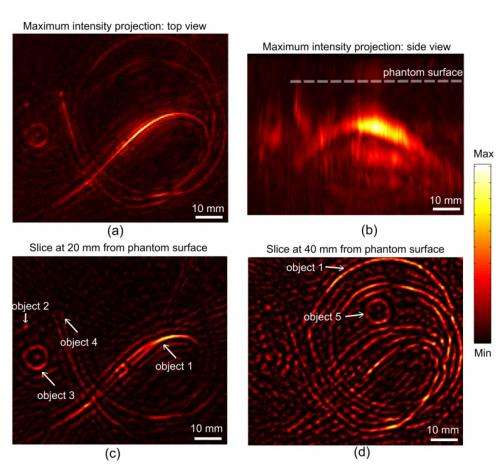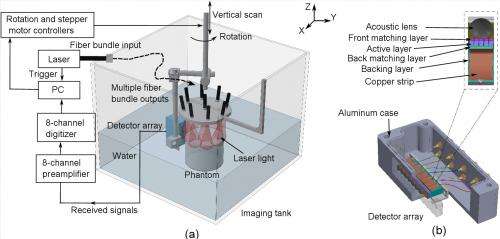Imaging breast cancer with light: Researchers unveil 'photoacoustic mammoscope'

Breast cancer is one of the most common forms of cancer and cancer deaths among women worldwide. Routine screening can increase breast cancer survival by detecting the disease early and allowing doctors to address it at this critical stage. A team of researchers at the University of Twente in the Netherlands have developed a prototype of a new imaging tool that may one day help to detect breast cancer early, when it is most treatable.
If effective, the new device, called a photoacoustic mammoscope, would represent an entirely new way of imaging the breast and detecting cancer. Instead of X-rays, which are used in traditional mammography, the photoacoustic breast mammoscope uses a combination of infrared light and ultrasound to create a 3-D map of the breast. The researchers describe their device in a paper published today in The Optical Society's (OSA) open-access journal Biomedical Optics Express.
A 3-D Map of the Breast
In the new technique, infrared light is delivered in billionth-of-a-second pulses to tissue, where it is scattered and absorbed. The high absorption of blood increases the temperature of blood vessels slightly, and this causes them to undergo a slight but rapid expansion. While imperceptible to the patient, this expansion generates detectable ultrasound waves that are used to form a 3-D map of the breast vasculature. Since cancer tumors have more blood vessels than the surrounding tissue, they are distinguishable in this image.

Currently the resolution of the images is not as fine as what can be obtained with existing breast imaging techniques like X-ray mammography and MRI. In future versions, Srirang Manohar, an assistant professor at the University of Twente who led the research, Wenfeng Xia, a graduate student at the University of Twente who is the first author on the new paper, and their colleagues expect to improve the resolution as well as add the capability to image using several different wavelengths of light at once, which is expected to improve detectability.
The Twente researchers, who belong to the Biomedical Photonic Imaging group run by Professor Wiendelt Steenbergen, have tested their prototype in the laboratory using phantoms—objects made of gels and other materials that mimic human tissue. Last year, in a small clinical trial they showed that an earlier version of the technology could successfully image breast cancer in women.
Manohar and his colleagues added that if the instrument were commercialized, it would likely cost less than MRI and X-ray mammography.
"We feel that the cost could be brought down to be not much more expensive than an ultrasound machine when it goes to industry," said Xia.
The next step, they say, will be to prepare for larger clinical trials. Several existing technologies are already widely used for breast cancer screening and diagnosis, including mammography, MRI, and ultrasound. Before becoming routinely used, the photoacoustic mammoscope would have to prove at least as effective as those other techniques in large, multicenter clinical trials.
"We are developing a clinical prototype that improves various aspects of the current version of the device," said Manohar. "The final prototype will be ready for first clinical testing next year."
More information: "Design and evaluation of a laboratory prototype system for 3D photoacoustic full breast tomography," W. Xia et al., Biomedical Optics Express, Vol. 4, Issue 11, pp. 2555-2569 (2013). www.opticsinfobase.org/boe/abs … fm?uri=boe-4-11-2555
Journal information: Biomedical Optics Express
Provided by Optical Society of America

















